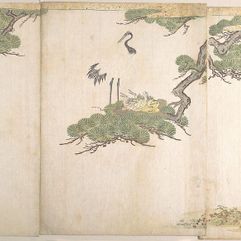

Utagawa Toyoharu
c. 1735 - 1814
Utagawa Toyoharu was a Japanese artist in the ukiyo-e genre, known as the founder of the Utagawa school and for his uki-e pictures that incorporated Western-style geometrical perspective to create a sense of depth.
Born in Toyooka in Tajima Province, Toyoharu first studied art in Kyoto, then in Edo (modern Tokyo), where from 1768 he began to produce designs for ukiyo-e woodblock prints. He soon became known for his uki-e "floating pictures" of landscapes and famous sites, as well as copies of Western and Chinese perspective prints. Though his were not the first perspective prints in ukiyo-e, they were the first to appear as full-colour nishiki-e, and they demonstrate a much greater mastery of perspective techniques than the works of his predecessors. Toyoharu was the first to make the landscape a subject of ukiyo-e art, rather than just a background to figures and events. By the 1780s he had turned primarily to painting. The Utagawa school of art grew to dominate ukiyo-e in the 19th century with artists such as Utamaro, Hiroshige, and Kuniyoshi.
Life and career
Utagawa Toyoharu was born c. 1735 in Toyooka in Tajima Province. He studied in Kyoto under Tsuruzawa Tangei of the Kanō school of painting. It may have been around 1763 that he moved to Edo (modern Tokyo), where he studied under Toriyama Sekien. The Toyo (豊) in the art name Toyoharu (豊春) is said to have come from Sekien's personal name Toyofusa (豊房). Some sources hold he also studied under Ishikawa Toyonobu and Nishimura Shigenaga. Other art names Toyoharu went under include Ichiryūsai (一竜斎), Senryūsai (潜竜斎), and Shōjirō (松爾楼). Tradition holds that the name Utagawa derives from Udagawa-chō, where Toyoharu lived in the Shiba district in Edo. His common name was Tajimaya Shōjirō (但馬屋 庄次郎), and he also used the personal names Masaki (昌樹) and Shin'emon (新右衛門).
Toyoharu's work began to appear about 1768. His earliest work includes woodblock prints in a refined, delicate style of beauties and actors. Soon he began to produce uki-e "floating picture" perspective prints, a genre in which Toyoharu applied Western-style one-point perspective to create a realistic sense of depth. Most were of famous sites, including theatres, temples, and teahouses. Toyoharu's were not the first uki-e-Okumura Masanobu had made such works since the early 1740s, and claimed the genre's origin for himself. Toyoharu's were the first uki-e in the full-colour nishiki-e genre that had developed in the 1760s. Several of his prints were based on imported prints from the West or China.
From the 1780s Toyoharu appears to have dedicated himself to painting, and also produced kabuki programs and billboards after 1785. He headed the painters involved in the restoration of Nikkō Tōshō-gū in 1796. He died in 1814 and was buried in Honkyōji Temple in Ikebukuro under the Buddhist posthumous name Utagawa-in Toyoharu Nichiyō Shinji (歌川院豊春日要居士).
Text courtesy of Wikipedia, 2024






